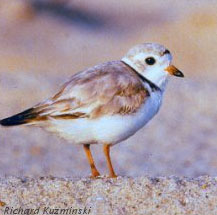
WEB MAIL BEACH
WEATHER HOTELS/MOTELS REAL ESTATE
VACATION
RENTALS RESTAURANTS
DINING OUR TOWNS FISHING - BOATING
CHARTER BOATS SHOPPING NIGHTLIFE THE OCEAN THE BAY
The Piping Plover
The adult has yellow-orange legs, a black band across the forehead from eye-to-eye, and a black ring around the base of its neck. Like other plovers, the Piping Plover runs in short starts and stops. When still, it blends into the open, sandy habitat of outer beaches where it feeds and nests. Piping Plovers Along the Atlantic CoastThe Piping Plover breeds on coastal beaches such as those found on the Delmarva Peninsula. The bird can be found from Newfoundland and southeastern Quebec to North Carolina to Florida. Some migrate to the Bahamas and West Indies. Common along the Atlantic coast in the 19th century, the birds nearly disappeared due to excessive hunting for the millinery trade. The Migratory Bird Treaty Act of 1918 helped the Piping Plover rebound in the 20th century to a peak in the 1940s but the population has declined again, apparently due to increased development and recreational use of beaches since World War II. The most recent surveys found about 1,000 pairs along the Atlantic. Find more info here: http://pipingplover.fws.gov/ Breeding and Feeding HabitsPiping Plovers return to their breeding grounds in late March or early April. After establishing a nesting territory and performing courtship rituals, the pairs form depressions in the sand somewhere on the high beach close to the dunes for nests that are sometimes filled with small stones or fragments of shell. The four eggs hatch in about 25 days and the downy young soon follow their parents for marine worms, crustaceans and insects they pluck from the sand. The eggs and the young are well camouflaged and will go undetected unless stepped on. When intruders come close, the young squat motionless on the sand while the parents attempt to attract the intruders' attention to themselves. They often do this by faking a broken wing. Surviving young fledge and fly in 30 days. Nests can be disrupted before the eggs hatch, though, by stormtides, predators or intruding humans. In those instances, plovers renest nearby and the birds hatched from those nests may not fly until late August. By mid-September, both adult and young plovers are on their way to their wintering areas. Threats to the Piping PloverSeveral factors contribute to the declining Piping Plover population along the Atlantic Coast, according to the Office of Endangered Species of the U.S. Fish and Wildlife Service:
The Endangered Species ActThe Piping Plover became a protected species under the Endangered Species Act on Jan. 10, 1986. Along the Atlantic, it is designated as threatened, meaning the population will continue to decline if not protected. The Endangered Species Act provides penalties for taking, harassing or harming the piping plover and offers some protection to its habitat. STEPS YOU CAN TAKE TO HELP THE PIPING PLOVER:
FOR MORE INFORMATION:
|
If you would like your business listed on Beach-net Contact us here!
Delaware Web Design & Internet Advertising - Coastal Images Inc.
Home | The Ocean | The Bay | Things To Do at the Beach | Restaurants & Dining | Hotels - Motels & Lodging Shopping | Beach Directions |
Our Towns | Beach Real Estate & Vacation Rentals | What’s New
What's Here | Beach Weather | Our Advertisers | Beach Maps

 The Piping Plover, a small, stocky, sandy-colored bird resembling a sandpiper, derives its name from its call notes, or plaintive, bell-like whistles, often heard before the birds are seen.
The Piping Plover, a small, stocky, sandy-colored bird resembling a sandpiper, derives its name from its call notes, or plaintive, bell-like whistles, often heard before the birds are seen.

